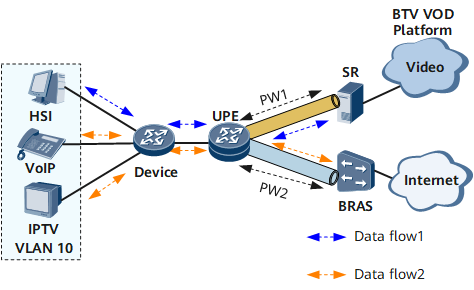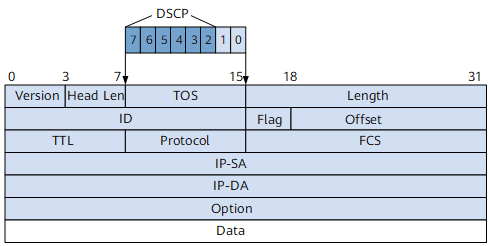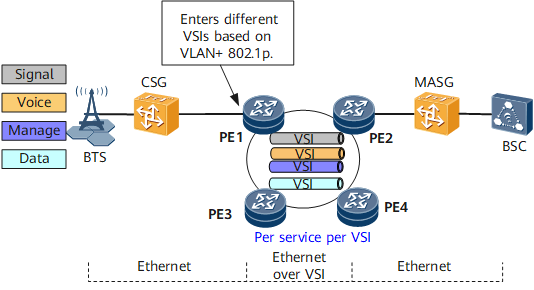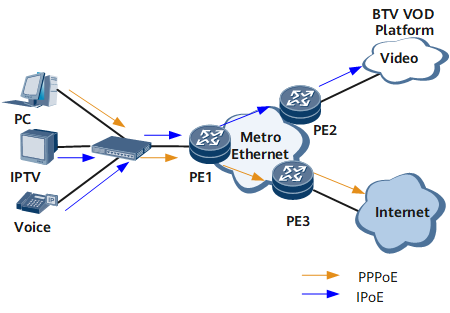Flexible Service Access Through Sub-interfaces of Various Types
Background
On an ME network, users and services are differentiated based on a single VLAN tag or double VLAN tags carried in packets and then access different Virtual Private Networks (VPNs) through sub-interfaces. In some special scenarios where the access device does not support QinQ or a single VLAN tag is used in different services, different services cannot be distributed to different Virtual Switching Instances (VSIs) or VPN instances.
As shown in Figure 1, the high-speed Internet (HSI), Voice over Internet Protocol (VoIP), and Internet Protocol Television (IPTV) services belong to VLAN 10 and are converged to the UPE through Switch; the UPE is connected to the SR and BRAS through Layer 2 virtual private networks (L2VPNs).
If the UPE does not support QinQ, it cannot differentiate the received HSI, VoIP, and IPTV services for transmitting them over different Pseudo Wires (PWs). In this case, you can configure the UPE to resolve the 802.1p priorities, DiffServ Code Point (DSCP) values, or EthType values of packets. Then, the UPE can transmit different packets over different PWs based on the 802.1p priorities, DSCP values, or EthType values of the packets.
In a similar manner, if the UPE is connected to the SR and BRAS through L3VPNs, the UPE can transmit different services through different VPN instances based on the 802.1p priorities or DSCP values of the packets.
Basic Concepts
As shown in Figure 1, sub-interfaces of different types are configured at the attachment circuit (AC) side of the UPE to transmit packets with different 802.1p priorities, DSCP values, or EthTypes through different PWs or VPN instances. This implements flexible service access. Flexible service access through sub-interfaces is a technology that differentiates L2VPN access based on the VLAN IDs and 802.1p priorities/DSCP values/EthType values in packets.
The sub-interfaces are classified in Table 1 based on service identification policies configured on them.
Sub-interface Type |
Concept |
Application |
|---|---|---|
VLAN sub-interface |
It is a sub-interface encapsulated with a VLAN ID. |
Sub-interfaces on different main interfaces can be encapsulated with the same VLAN ID. VLAN sub-interfaces are bound to VSIs/Virtual Private Wire Services (VPWSes) or VPN instances to access L2VPNs or L3VPNs. |
Untagged sub-interface |
It is a sub-interface that supports untagged+DSCP. An untagged sub-interface receives untagged packets with DSCP values. |
An access device on an ME network differentiates services based on their DSCP values. Untagged packets are transmitted through different VPN instances based on the DSCP values of the packets. After untagged+DSCP is configured on a sub-interface, note the following:
If neither of the preceding conditions exists, the packet is discarded. After untagged+DSCP is configured on a sub-interface, its main interface cannot process Layer 3 packets, and all Layer 3 packets are processed on the untagged sub-interface on the NetEngine 8000 F. NOTE:
Untagged+DSCP is applicable to only the IP and L3VPN access scenario. |
802.1p sub-interface |
It is a sub-interface that supports VLAN+802.1p. The VLAN can be a single VLAN or a VLAN range. If a single VLAN is specified, it is a Dot1q sub-interface; if a VLAN range is specified, it can be a sub-interface for Dot1q VLAN tag termination or a QinQ stacking sub-interface. An 802.1p sub-interface receives tagged packets with 802.1p priorities. |
An access device on an ME network differentiates services based on their VLAN IDs and 802.1p priorities. After VLAN+802.1p is configured on a sub-interface, note the following:
If neither of the preceding conditions exists, the packet is discarded. |
DSCP sub-interface |
It is a sub-interface that supports VLAN+DSCP. Here, the VLAN can be a single VLAN or a VLAN range. If a single VLAN is specified, it is a Dot1q sub-interface; if a VLAN range is specified, it can be a sub-interface for Dot1q VLAN tag termination or a QinQ stacking sub-interface. A DSCP sub-interface receives tagged packets with DSCP values. |
An access device on an ME network differentiates services based on their VLAN IDs and DSCP values. After VLAN+DSCP is configured on a sub-interface, note the following:
If neither of the preceding conditions exists, the packet is discarded. |
EthType sub-interface |
It is a sub-interface that supports VLAN+EthType. Here, the VLAN can be a single VLAN or a VLAN range. If a single VLAN is specified, it is a Dot1q sub-interface; if a VLAN range is specified, it can be a sub-interface for Dot1q VLAN tag termination or a QinQ stacking sub-interface. An EthType sub-interface receives tagged packets with different EthTypes. |
An access device on an ME network differentiates services based on their VLAN IDs and EthTypes. After VLAN+EthType is configured on a sub-interface, there are the following situations:
If neither of the preceding conditions exists, the packet is discarded. |
Default sub-interface |
It is a sub-interface that supports VLAN+default. Here, the VLAN can be a single VLAN or a VLAN range. If a single VLAN is specified, it is a Dot1q sub-interface; if a VLAN range is specified, it can be a sub-interface for Dot1q VLAN tag termination or a QinQ stacking sub-interface. A default sub-interface receives tagged packets with no 802.1p priorities/DSCP values/EthType values. |
A VLAN+default-enabled sub-interface identifies packets based on their VLAN IDs without 802.1p priorities/DSCP values/EthType values. |
802.1p and EthType
Figure 2 shows the format of a VLAN frame defined in IEEE 802.1Q.
As shown in Figure 2, the 802.1p priority is represented by a 3-bit PRI (priority) field in a VLAN frame defined in IEEE 802.1Q. The value ranges from 0 to 7. The greater the value, the higher the priority. When the switching device is congested, the switching device preferentially sends packets with higher priorities. In flexible service access, this field is used to identify service types so that different services can access different L2VPNs/L3VPNs.
The EthType is represented by a 2-bit LEN/ETYPE field, as shown in Figure 2. In flexible service access, this field is used to identify service types based on EthType values (PPPoE or IPoE) so that different services can access different L2VPNs.
DSCP
As shown in Figure 3, the DSCP is represented by the first 6 bits of the Type of Service (ToS) field in an IPv4 packet header, as defined in relevant standards. The DSCP guarantees QoS on IP networks. Traffic control on the gateway depends on the DSCP field.
In flexible service access, this field is used to identify service types so that different services can access different L2VPNs/L3VPNs.
On the network shown in Figure 4, when a CSG accesses an IP station, VPWS is not required on the CSG and MASG. After the CSG receives IP packets, it performs the following:
The CSG directly encapsulates the packets with VLAN IDs and 802.1p priorities for differentiating services. The CSG encapsulates the IP packets as follows:
Encapsulates different users with different VLAN IDs.
Encapsulates different services with different 802.1p priorities.
Encapsulates different services of the same user with the same VLAN ID but different 802.1p priorities.
Encapsulates different services of different users with different VLAN IDs but the same or different 802.1p priorities.
Then, the CSG sends the encapsulated packets to PE1. After PE1 receives the packets, its 802.1p sub-interface resolves the packets to obtain their VLAN IDs and 802.1p priorities. The packets then access different VSIs through priority mapping. In this manner, different services are transmitted to PE2 through different VSIs.
After PE2 receives the packets, it sends the packets to the MASG.
The MASG then transmits the packets to the BSC.

Huawei high-end routers can function as PEs. In this scenario, only the configurations of PEs are mentioned. For detailed configurations of other devices, see the related configuration guides.
You can configure the 802.1p priorities on the CSG through commands.
For details on L2VPNs, see the chapters "VPWS" and "VPLS" in the NetEngine 8000 F Feature Description - VPN.
VLAN+EthType-based L2VPN Access
On the network shown in Figure 5, packets sent from PC users are encapsulated with PPPoE whereas packets sent from IPTV and voice users are encapsulated with IPoE. To ensure that packets of different EthTypes are transmitted to different remote servers, you can configure VLAN+EthType on the edge device of the ME network to access an L2VPN. In this manner, the edge device priorities services based on VLAN+EthType, distributes services to different VSIs or VPWSs through priority mapping, and transparently transmits PPPoE packets to the BRAS and IPoE packets to the remote SR.
On the network shown in Figure 6, after the CSG receives IP packets, it performs the following:
The CSG directly encapsulates the packets with VLAN IDs and DSCP values for differentiating services. The CSG encapsulates the IP packets as follows:
Encapsulates different users with different VLAN IDs.
Encapsulates different services with different DSCP values.
Encapsulates different services of the same user with the same VLAN ID but different DSCP values.
Encapsulates different services of different users with different VLAN IDs but the same or different DSCP values.
Then, the CSG sends the encapsulated packets to PE1. After PE1 receives the packets, its DSCP sub-interface resolves the packets to obtain their VLAN IDs and DSCP values. The packets then access different VSIs through priority mapping. In this manner, different services are transmitted to PE2 through different VSIs.
After PE2 receives the packets, it sends the packets to the RNC.

Huawei high-end routers can function as PEs. In this scenario, only the configurations of PEs are mentioned. For detailed configurations of other devices, see the related configuration guides.
You can configure the DSCP values on the CSG through commands.
For details on L2VPNs, see the chapters "VPWS" and "VPLS" in the NetEngine 8000 F Feature Description - VPN.
As shown in Figure 7, after the CSG receives IP packets, it performs the following:
The CSG directly encapsulates the packets with VLAN IDs and DSCP values for differentiating services. The CSG encapsulates the IP packets as follows:
Encapsulates different users with different VLAN IDs.
Encapsulates different services with different DSCP values.
Encapsulates different services of the same user with the same VLAN ID but different DSCP values.
Encapsulates different services of different users with different VLAN IDs but the same or different DSCP values.
Then, the CSG sends the encapsulated packets to PE1. After PE1 receives the packets, its DSCP sub-interface resolves the packets to obtain their VLAN IDs and DSCP values. The packets then access different VPN instances through priority mapping. In this manner, different services are transmitted to PE2 through different VPN instances.
After PE2 receives the packets, it sends the packets to the RNC.

Huawei high-end routers can function as PEs. In this scenario, only the configurations of PEs are mentioned. For detailed configurations of other devices, see the related configuration guides.
You can configure the DSCP values on the CSG through commands.
For details on L2VPNs, see the chapter "BGP/MPLS IP VPN" in the NetEngine 8000 F Feature Description - VPN.
As shown in Figure 8, when a CSG accesses an IP station, VPWS is not required on the CSG and MASG. After the CSG receives IP packets, it performs the following:
The CSG directly encapsulates the packets with VLAN IDs and 802.1p priorities for differentiating services. The CSG encapsulates the IP packets as follows:
Encapsulates different users with different VLAN IDs.
Encapsulates different services with different 802.1p priorities.
Encapsulates different services of the same user with the same VLAN ID but different 802.1p priorities.
Encapsulates different services of different users with different VLAN IDs but the same or different 802.1p priorities.
Then, the CSG sends the encapsulated packets to PE1. After PE1 receives the packets, its 802.1p sub-interface resolves the packets to obtain their VLAN IDs and 802.1p priorities. The packets then access different VPN instances through priority mapping. In this manner, different services are transmitted to PE2 through different VPN instances.
After PE2 receives the packets, it sends the packets to the RNC.

Huawei high-end routers can function as PEs. In this scenario, only the configurations of PEs are mentioned. For detailed configurations of other devices, see the related configuration guides.
You can configure the 802.1p priorities on the CSG through commands.
For details on L2VPNs, see the chapter "BGP/MPLS IP VPN" in the NetEngine 8000 F Feature Description - VPN.







